Thursday Oct. 5th, 2006
We arrived at Incheon International Airport at about 11p.m. The guesthouse free airport shuttle van picked us up. The guesthouse was just a few minutes drive away from the airport, which is why we chose to stay there since our flight got in late that night. The area around our guesthouse was kinda weird...all industrial-like. The airport is on an island off the coast of South Korea.
Friday Oct. 6th, 2006
In the morning we took a 1 hour bus ride into Seoul. We went to the hostel first to check in. A bit of confusion at first because the guy working at the desk couldn't find our reservation. In the end if all worked out though.
This day was also the Korean Chusok Holiday (called Korean Thanksgiving Day). We had no clue there was a holiday this weekend in Korea until we were on the plane and reading the newspaper and noticed all these articles about the holiday. Basically the holiday is when people go home to their families and hometowns. More then half of the population of Seoul leaves for this holiday. So our first sight of Seoul was not the usual Seoul - much less crowded. Plus most of all the restaurants and shops were closed. But, we found a great restaurant to eat at that everyone was eating at because it was the only one open. We had bibimbap, which is a famous Korean dish of rice, vegetables, and egg served in a steaming hot bowl and you mix it all up and eat it. It's delicious! This was the best (and cheapest meal - under $4) of the whole trip. We hadn't learned much Korean yet and had a difficult time ordering, but someone working there spoke Japanese, so instead we ordered in Japanese.
photo taken by andy of the restaurant
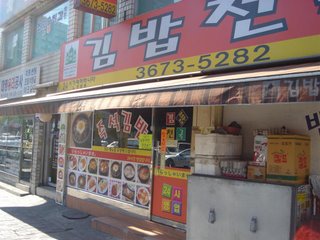
After eating we went to Gyeongbokgung, which was located very close to our hostel. It's the main palace of Seoul. It was beautiful weather, sharp sun shining down. Because of the holiday we didn't have to buy an entrace ticket, and also there were many people visiting, lots of families. Below are a few photos of the palace.
palace photos
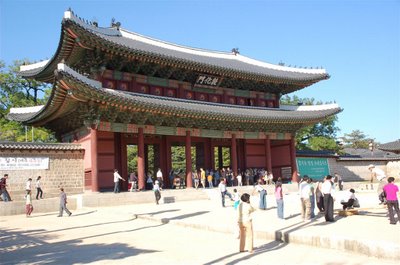


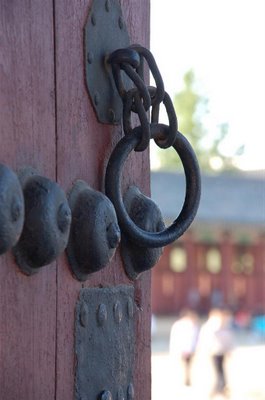
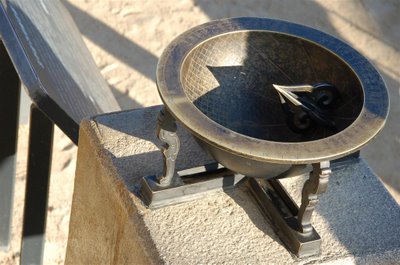
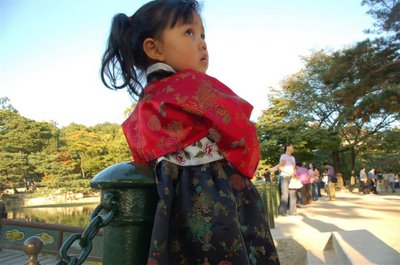
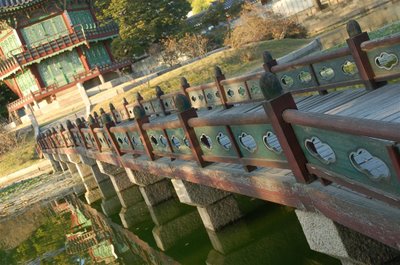
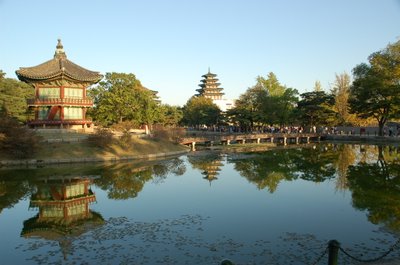
After that we just walked around, went to Sinchon area hoping to find a vegetarian restaurant we read about in Lonely Planet that was supposed to be located in this area, but couldn't find it. But it was a neat area to see anyway, near Ewa Women's University and known as an area with many females due to the college, and there were loads of shops for girls - clothing, make-up, etc.
Saturday, Oct. 7th 2006
DMZ Tour. By far the best part of the trip.
so much to say about this.
I made reservations for the tour a few weeks in advance. i was told (and also read in Lonely Planet) that the best DMZ tour is the one by the USO, a tour by the U.S. Military. It takes you to all 3 sites and it's the cheapest tour too, $42 while most tours are over $60 and don't take you everywhere. On our tour the majority were Americans, but there were also Australians, Canadians, a couple from Denmark, and a Brazilian. We became friends with an Australian teaching English in Korea, and a Japanese Brazilian traveling around.
The tour was from 10a.m. to 8p.m.
The DMZ is a the Demilitarized Zone the was created after the war in the 1950s to create a peace zone, or a buffer if you will, between the North and South. It's the most heavily guarded border in the world.
The first place we visited was the Observatory Deck where you can look over the DMZ and see into North Korea. I heard we wouldn't be able to take many photos, so I didn't bring my camera, but luckily Andy did, because it ended up we were allowed to take some photos. So all photos of the DMZ area shown below were taken with Andy's camera. On the Observatory Deck, there was a yellow line and we had to take photos from behind the yellow line. The yellow line was pretty far back, so it was tough to get some good pictures. The reason the line was so far back was so when you took pictures, the pictures would only include the North Korean side and so nothing of the South Korean side would appear in the pictures. quite strategically placed.
you could smell and sense the air was different. since no one has really lived in the DMZ zone for so many years, there's no pollution and it's an excellent eco-system and environmentalists hope to keep the area as a wildlife reservation area when (if?!) the 2 countries unite.
photos of the observatory deck

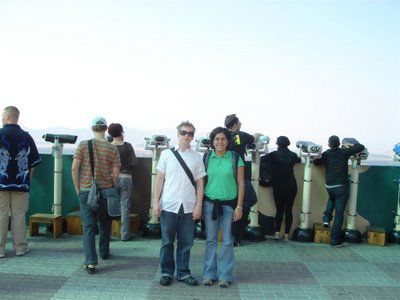
next we visited one of the tunnels. tunnels? ok so along the border apparently north korea had ordered the north korean soldiers to dig tunnels under the dmz, and all tunnels heading for seoul. in 1974 south korea found the first tunnel, by accident. then a couple or few years later they found a 2nd tunnel, and then found a 3rd tunnel in 1990. there is supposed to be 20 tunnels, so only 3 of 20 tunnels have been discovered. they can't find the other tunnels because north korea has filled them up with water and the sonar test used only tests for hollow areas.
when south korea discovered the tunnels, north korea denied it and put ash all over the tunnels saying it was a coal mine. but it's all granite and there is no coal mining in that area.
we got to go down into one of the tunnels and walk half way through, about 250 meteres. we had to wear hard hats. very interesting. they say the tunnel probably took the north koreans about 5 years to build because they do not have advance technology. if they did, it should have taken only 1 year. they estimate10,000 soldiers can move through the tunnel in 1 hour. no photos of this part because we weren't allowed to take photos here.
next we visited a train station that was built to connect south and north korea.
The station has never been used. The day before it was supposed to officially open, north korea cancelled and called the whole thing off. So this brand new station just sits there empty and unused. Here is where we got our passport stamped, basically stating we were in the DMZ area. Pretty cool.
The next part was the best part of the tour. We went to the JSA (Joint Security Area) – the actual border line between north and south korea. Before we went on this part of the tour, we had a briefing by the U.S. military and basically had to “sign our life away”, saying if anything happened to us while at the border they would protect us, but no guarantee. quite intense. It’s hard to explain what the border was like…you just have to see the photos.
The photo below is the slab of concrete the marks the border. The north side having dirt/sand, and the south side having gravel.
This next photo is the room where north korea and south korea meet for talks, sitting at the table that’s right on the border, with UN people on the ends of the table. So in this room when we walked on the other side of the table, we were in north korea.
The military guys you see in these photos are the ROCK Military. They stand in a taekwondo stance and wear dark sunglasses to intimidate the north koreans. If we had tried to get in their way, they would have physically stopped us. in the picture below, behind him is the door to north korea.
You can just feel the tension at the border.
In this next photo the white stakes mark the border and there are landmines scattered about.
The next photos.. ok so when the DMZ was made, there was village that fell in the zone. They were given the choice to leave or to live there. Today about 220 people live in this South Korea village in the DMZ area. The military protects them 24/7. They have to be in their homes when it gets dark and at 11pm or 12am they have to have all their doors and windows locked and shut. Their housing is subsidized and are given much more land to farm then other Koreans. They live very comfortably and make about $80,000 a year. They have to live in the village 8 months out of the year. The men are required to marry someone outside of the village.
This South Korean village in the South Korean side of the DMZ had a flag, and then a company donated a bigger and nicer flag to them. So what did North Korea do? They put up a flag that was much bigger and much higher up then the South Korea Flag. That’s what you see in this next photo.
The flag is one of the biggest flags in the world, and one of highest flag towers. It’s about 60 meters and dry weight is about 600 pounds. It takes 50 men to lower the flag which they have to do in bad weather otherwise it will rip under it’s own weight.
The “town” you see around the flag is not a real town. It’s called “propaganda town” which the North Koreans made just for show. They have lights that go on when it gets dark and all go off at the same time. Occassionally, maybe when someone important is coming to vist, they will send people to go live in the town for about 2 days. Also sometimes you will see people there who are just maintaining and upkeeping the village, but not living there.
the bridge of no return

Sunday, Oct 8th, 2006
Still had a list of things we wanted to get done.. Went to Namdaemun Market - famous open-air market in Seoul. I've been to many markets like this in other countries. I wasn't looking to shop, but it was worth a visit. We did buy our one souvenir here though. Koreans use stainless steal chopsticks, and usually at meals you are given stainless steal chopsticks and a spoon. I figured it was something useful, because otherwise I hate buying useless stuff. We went to many shops and tried bargaining, but were outright denied. Even though it was about a $2, you know it would have been half priced for Koreans.
photos of the market

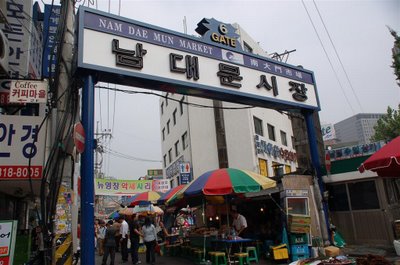
I usually avoid street vendors because don't know how well cooked and safe the food is, etc., when traveling, but this one street vendor was making these cinamon bread things that smelled so good. They were fresh as he was making them in front of us. So I had to have one, and it was decilious.
street vendor photo

We then headed to the Seoul International Drum Festival. Another thing that we didn't even know was going on that weekend until someone mentioned it to us - good timing. We saw 3 groups. Two Korean groups, and a Belgium group. The first Korean group was an all-female group, and honestly while they looked good, they didn't sound good.
photos of first group

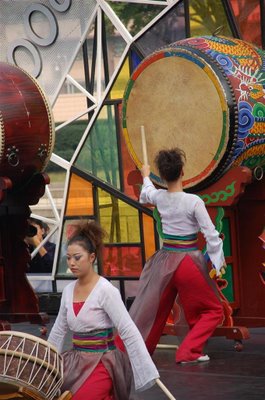
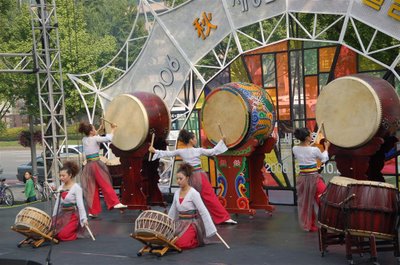
the 2nd group was the belgium group, similar to Stomp style drumming. they were good, quite entertaining. i liked how there was a vast age range among this group.
photos of the belgium group
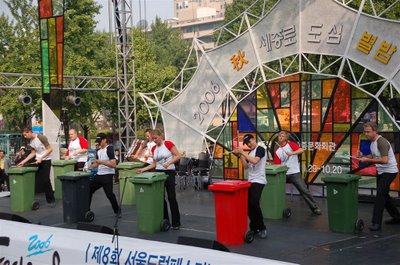
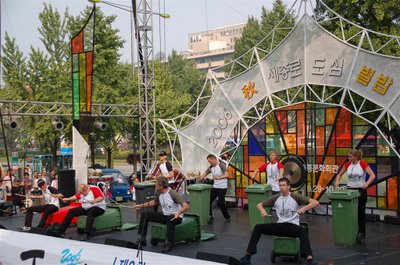

the 3rd group was the best. an all-male traditional korean drum group. it's so hard to describe, but i took lots of photos. they sounded really good and was just incredible to watch them. the sound was unique as well as the style. they just flowed really well.
photos of 3rd group
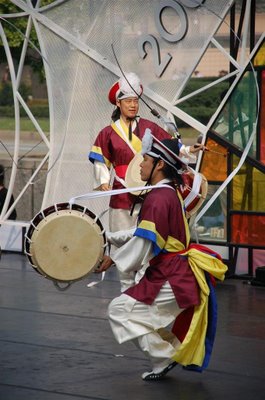
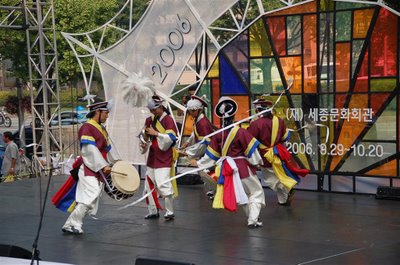
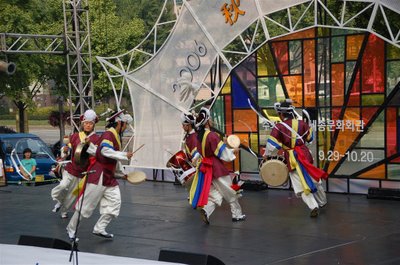

restaurant in Insadong with people we met all staying at the same hostel, tolliver (from L.A. living in tokyo working as a programmer), andy, me, melissa (from australia teaching english in korea, we met her on the dmz tour), brad (from canada on his way to live in australia). we all had a late lunch after the drum festival.
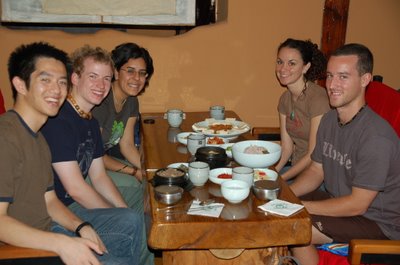
After that Andy and I went to a tea house. We were staying near Insadong, which is known for many tea houses.
photos of tea house
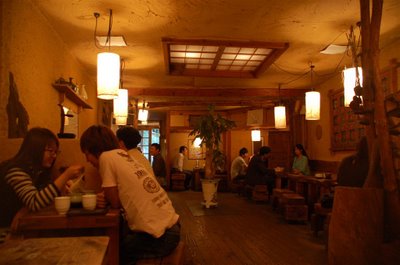
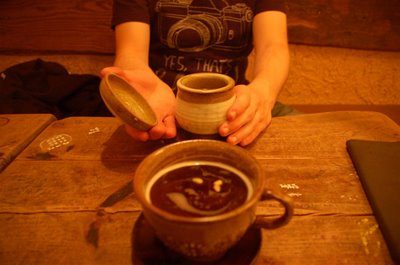
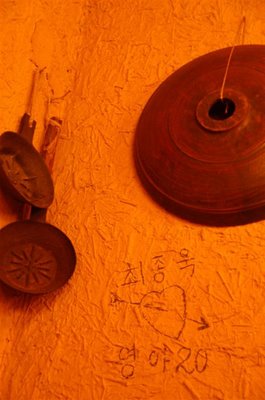
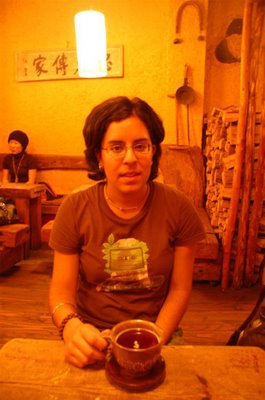
Next we headed to Seoul Tower where we met with Tolliver and Brad again. We had put off going to the tower the previous couple nights, and of course those nights the sky was clear, but this night it was cloudy and hazy. But it was still worth going to.

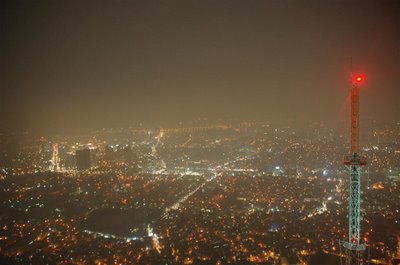
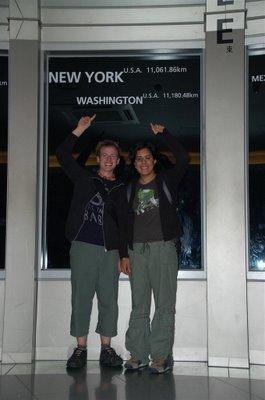 in the photo above: around the tower they had marked how many kilometers it was to different countries around the world from the tower, and the distance to NYC and D.C. was the closest to Delaware.
in the photo above: around the tower they had marked how many kilometers it was to different countries around the world from the tower, and the distance to NYC and D.C. was the closest to Delaware.Monday, Oct. 9th, 2006
This day we did a day trip to Suwon, about a 1 hour subway/train ride from Seoul. transportation costs are quite cheap in Korea. it only cost us about $1.20 one way, while in Japan it would have been $12 !!
Suwon is known for the Hwaseong, a fortress wall and it's a UNESCO World Heritage Site. The fortress wall is still intact and runs about 5 km (we walked about 3 or 4 km of it). The city of Suwon is built around the wall. It's really quite neat. again i took lots of photos of this place, see some below.
fortress photos
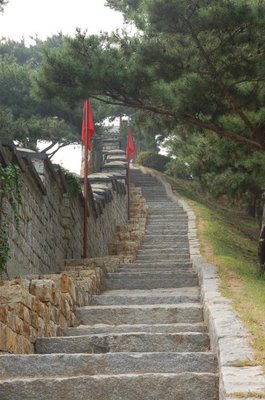
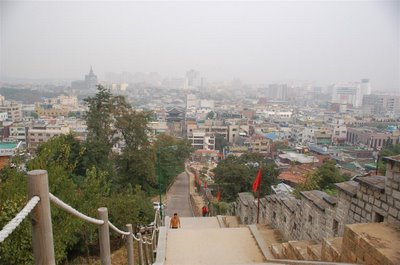
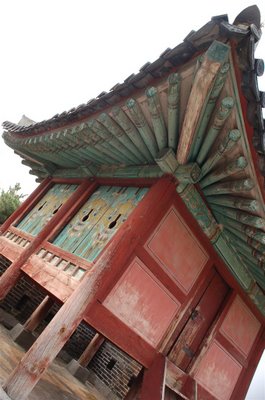
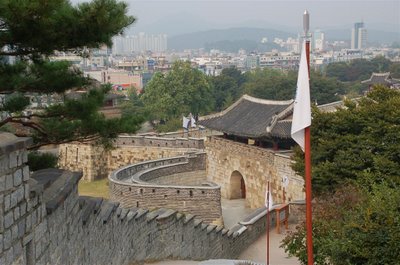

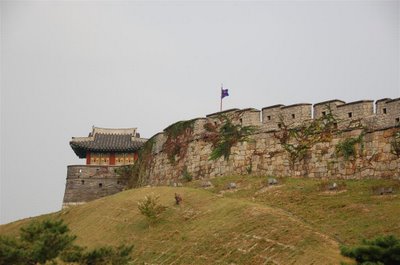
They recently started a 1,000 wan ticket fee to walk around the wall. We didn't buy a ticket and just a started walking around the wall, hoping we could avoid the ticket fee. But then we passed a ticket stand and 2 old guys started haggling us yelling "hello! hello! ticket! ticket!" We tried to act dumb and keep walking but it didn't work. 1,000 wan is only about a $1, but it was just annoying because there were many other Koreans walking along the wall who didn't have to pay. They said there would be other ticket check points along the wall, but that first one was the only one.
When we first got to Suwon, we ate in the foodcourt at the train station, had bibimbap again.
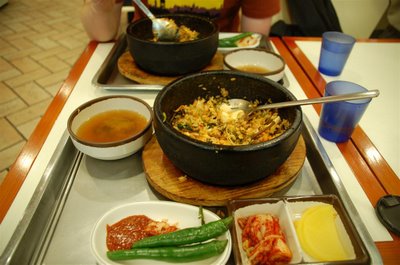
Another interesting thing about our trip to Suwon was the bus ride from the Suwon train station to the fortress wall. It was only about a 10 or 15 minute bus ride, but it was crazy! It's hard to explain, and you need to have been there to understand. Briefly, all these old ladies and guys were pushing and shoving like a race to get on the bus and get the best seat. Then a guy came on the bus selling foot pads to put in your shoes, and yeah you see it a lot where people try selling you things, but this guy was hysterical, wouldn't give up, and made people take off their shoes and try them on. and the thing is many people actually bought them! And to get off the bus was an experience because it would suddenly stop and quickly you had to get off like you were being thrown off. quite crazy. again, had to have been there.
When we got back to Seoul from Suwon, we had dinner, walked around a bit then headed back to the hostel. Once back at the hostel, Andy was checking his email and noticed on the internet that North Korea had done a nuclear test that morning. We had no idea! We were completely oblivious! That morning while we were walking to the subway we had noticed many policeman with riot shields, but didn't think anything of it! It was really interesting.
Tuesday, Oct. 10, 2006
leave korea to go back home ('home' now being japan).
the day started by waking up at 6a.m.
leave hostel
walked 5 min
bus 1 hour
plane 2.5 hours
train 1 hour
bus 5 hours
train 12 minutes
walked 7 minutes
home by 10p.m.
end thoughts
People had said Seoul is just a cheaper Tokyo. Well whoever said that is completely wrong! It is cheaper, but Seoul, and South Korea as a whole, is really quite different...definitely unique in its own way. The people seemed more pushy on subways, trains, etc., but also very nice. I think they seemed more conservative in the way they dressed compared to the Japanese, but more outwardly affectionate, the way families were with their kids and just couples on the street. Also they didn't seem overly obsessed with bowing like the Japanese are. Just many noticeable differences that I observed while I was there.
Another main difference was that Korea was definitely more dirty. Japan is much more clean, that's for sure. Also Korea, especially Seoul, had more air pollution. Our first 2 days there the weather was excellent, clear blue skies and sunny. But the second two days, it was pretty cloudy and hazy, but at least no rain. Apparently here in Japan, while we were in Korea, a typhoon came by with very heavy rains and classes were even cancelled at the schools.
All in all, a great trip. an awakening and rewarding experience. after talking to people from various countries i met at the hostels, and hearing about their travels, it only worsened my travel bug - it's an addiction.
currently planning the next trip: thailand, cambodia, and laos. backpacking around for 2 weeks in dec. and jan.
i had to send out my passport to the tokyo u.s. embassy to have more pages added! i'm just about out of blank pages and laos and cambodia require full pages for the visas.
until the next trip... i hope to enjoy fall weather (my favorite season) and visit places around this area to see the leaves (going to mount zao to do that tomorrow), continue to help the photography club students in the dark room, plan the english club halloween party, participate in a festival with our dance group in november, and well those are just some things off the top of my head.
there are lots of more photos to see! so please check out rest of the photos here on my flickr site. you can click on the link on the upper right corner of the page to view them as a slideshow.


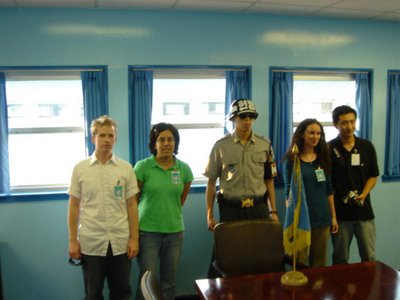
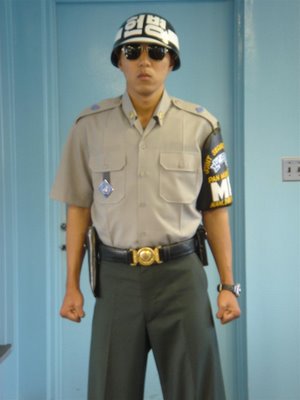
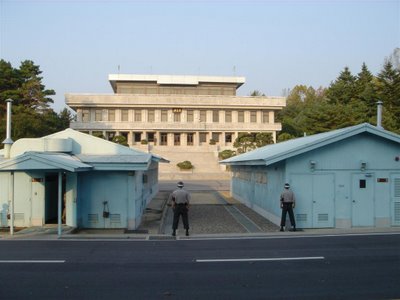
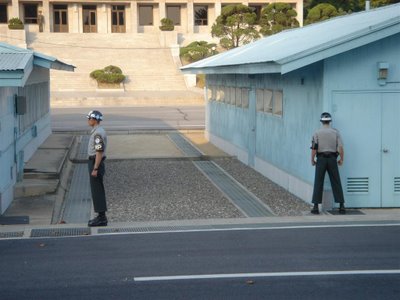
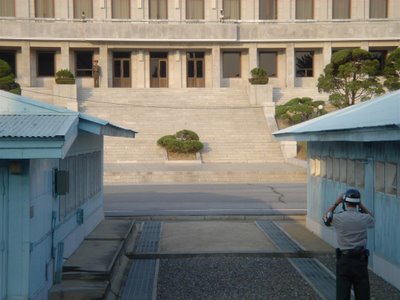

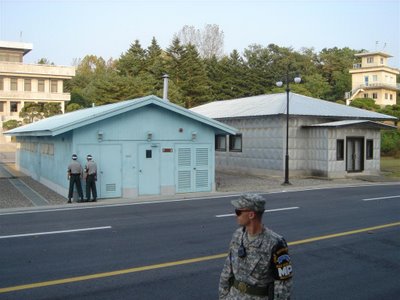

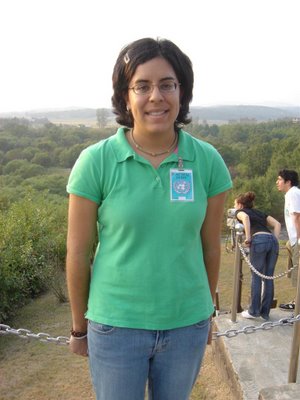
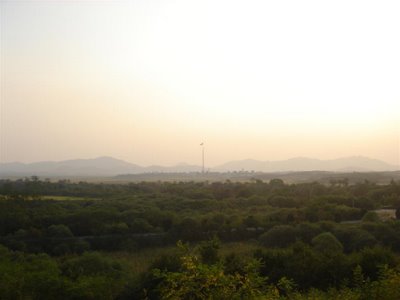
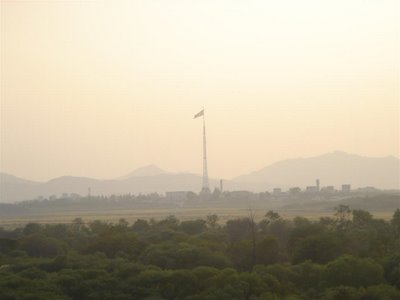
i just read this and looked at all of your pictures on flickr... amazing! i MUST travel with you next time :)
ReplyDeleteHi Tanya,
ReplyDeleteWow! What a trip! The DMZ sounds frightening! and I thought about you a lot when the nuclear testing in North Korea was discussed. Your pictures are great! So much color in the drumming groups, the buidlings,etc. Grater lake is beautiful! Seeing your picturs prompted me to mention them to one of our volunteers. Turned out he served in Korea during the war in the early 50's. He said it wasn't a pretty place then. No paved roads, so much poverty. I am proud of you for wanting to make so many trips. I don't think I could handle all that. It sounds like you really have the travel bug. You are such an adventurer! This is quite an opportunity that you have and it sounds like you are making the most of it! We miss you. Love, Carol